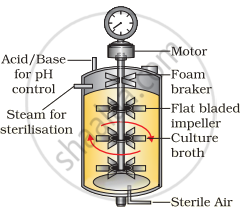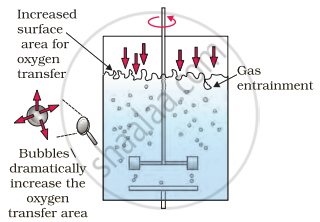Advertisements
Advertisements
Question
Illustrate the design of a bioreactor. Highlight the difference between a flask in your laboratory and a bioreactor which allows cells to grow in a continuous culture system.
Solution
Small volume cultures cannot yield appreciable quantities of products. To produce in large quantities, the development of bioreactors, where large volumes (100-1000 litres) of culture can be processed, was required. Thus, bioreactors can be thought of as vessels in which raw materials are biologically converted into specific products, individual enzymes, etc., using microbial plant, animal or human cells. A bioreactor provides the optimal conditions for achieving the desired product by providing optimum growth conditions (temperature, pH, substrate”, salts, vitamins, oxygen).

Simple stirred-tank bioreactor

Sparged stirred-tank bioreactor through which sterile air bubbles are sparged
| Flask | Bioreactor |
| Flask is used for small laboratory scale testing of a culture. | Bioreactor is used for commercial production |
| The cells harbouring cloned genes of interest may be grown on a small scale in the laboratory. | The cells can also be multiplied in a continuous culture system wherein the used medium is drained out from one side while the fresh medium is added from the other to maintain the cells in their physiologically most active log/exponential phase. This type of culturing method produces larger biomass leading to higher yields of desired protein. |
APPEARS IN
RELATED QUESTIONS
Name two commonly used bioreactors.
Draw a labelled sketch of sparged-stirred-tank bioreactor. Write its application.
From what you have learnt, can you tell whether enzymes are bigger or DNA is bigger in molecular size? How did you know?
Describe briefly the following:
Bioreactors
A single strand of nucleic acid tagged with a radioactive molecule is called ______.
Gene Amplification using primers can be done by ______.
An antibiotic resistance gene in a vector usually helps in the selection of ______.
Significance of 'heat shock' method in bacterial transformation is to facilitate ______.
Which of the following should be chosen for best yield if one were to produce a recombinant protein in large amounts?
Bioreactors are the containment vehicles of any biotechnology-based production process. For large scale production and for economic reasons the final success of biotechnological process depends on the efficiency of the bioreactor.
Answer the following questions w.r.t. the given paragraph:
- List the operational guidelines that must be adhered to so as to achieve optimisation of the bioreactor system. Enlist any four.
- Mention the phase of the growth we refer to in the statement "Optimisation of growth and metabolic activity of the cells".
- Is the biological product formed in the bioreactor suitable for the intended use immediate? Give reason in support of your answer.
